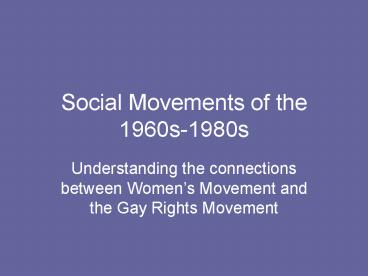Social Movements of the 1960s1980s - PowerPoint PPT Presentation
1 / 11
Title:
Social Movements of the 1960s1980s
Description:
The traditional perception of 1950s housewives continued into the early 1960s, ... The category 'sex' was included as a last-ditch effort to kill the bill. ... – PowerPoint PPT presentation
Number of Views:21
Avg rating:3.0/5.0
Title: Social Movements of the 1960s1980s
1
Social Movements of the 1960s-1980s
- Understanding the connections between Womens
Movement and the Gay Rights Movement
2
Timeline of the Womens Movement
- The traditional perception of 1950s housewives
continued into the early 1960s, although a 1/3 of
women were working outside the home in 1960. - In 1963, Betty Friedan published a landmark book,
The Feminine Mystique. In it she documented the
emotional and intellectual oppression that
middle-class educated women were experiencing
because of limited life options. The book became
an immediate bestseller, and inspired thousands
of women to look for fulfillment beyond the role
of homemaker.
3
Timeline of the Womens Movement
- During the 1960s, thousands of young women on
college campuses were playing active roles within
the anti-war and civil rights movement. - Many women finding their efforts blocked by men
who felt leadership of these movements was their
own province - Women began forming their own "women's
liberation" organizations to address their role
and status within these progressive movements and
within society at large.
4
Timeline of the Womens Movement
- 1964 Civil Rights Act was passed, prohibiting
employment discrimination on the basis of sex as
well as race, religion, and national origin. The
category "sex" was included as a last-ditch
effort to kill the bill. But it passed,
nevertheless. - With its passage, the Equal Employment
Opportunity Commission was established to
investigate discrimination complaints.
5
TITLE IX
- Title IX of the Educational Amendments of 1972 is
the landmark legislation that bans sex
discrimination in schools, whether it be in
academics or athletics. Title IX states - "No person in the U.S. shall, on the basis of
sex be excluded from participation in, or denied
the benefits of, or be subjected to
discrimination under any educational program or
activity receiving federal aid."
6
The Equal Rights Amendment
- The ERA was written in 1923 by Alice Paul,
suffragist leader and founder of the National
Woman's Party. She and the NWP considered the
ERA to be the next necessary step after the 19th
Amendment (affirming women's right to vote) in
guaranteeing "equal justice under law" to all
citizens.
7
The Equal Rights Amendment
- The ERA was introduced into every session of
Congress between 1923 and 1972. - In 1972 it was passed and sent to the states for
ratification. The seven-year time limit in the
ERA's proposing clause was extended by Congress
to June 30, 1982, but at the deadline, the ERA
had been ratified by 35 states, leaving it three
states short of the 38 required for ratification.
- It has been reintroduced into every Congress
since that time.
8
Timeline of the Gay Rights Movement
- During the 1950s, it would have been dangerous
and illegal to register any kind of pro-gay
organization. The founders of the first major gay
rights groups had to protect themselves by using
code. - Most states classify consensual gay sex as a
felony on par with sexual assault--sometimes with
prison sentences of up to 20 years.
9
Timeline of the Gay Rights Movement
- In the 1960s, many gay people participated in
Civil Rights Activism. - The 1969 Stonewall Riots In 1969, NYPD raided a
gay bar in Greenwich Village and started
arresting employees and drag performers. A crowd
of some 2,000 lesbian, gay, and transgender
supporters of the bar took on the police, forcing
them into the club. Three days of riots ensued.
10
Timeline of the Gay Rights Movement
- In 1973, members of the American Psychiatric
Association began to realize that homophobia was
the real social problem. They announced that they
would be removing homosexuality from the next
printing of the DSM-II, and spoke out in favor of
antidiscrimination laws that would protect
lesbian and gay Americans.
11
Timeline of the Gay Rights Movement
- In the 1980 election, leaders of the Religious
Right were squarely behind Ronald Reagan. - Democratic leaders had everything to gain and
little to lose by supporting gay rights, so they
inserted a new plank in the party platform "All
groups must be protected from discrimination
based on race, color, religion, national origin,
language, age, sex or sexual orientation."






























